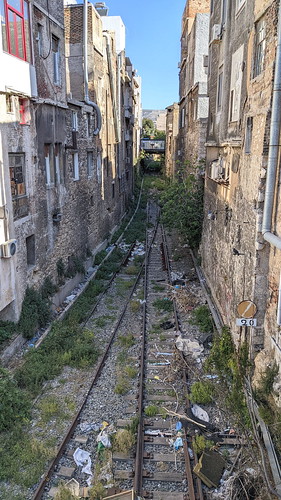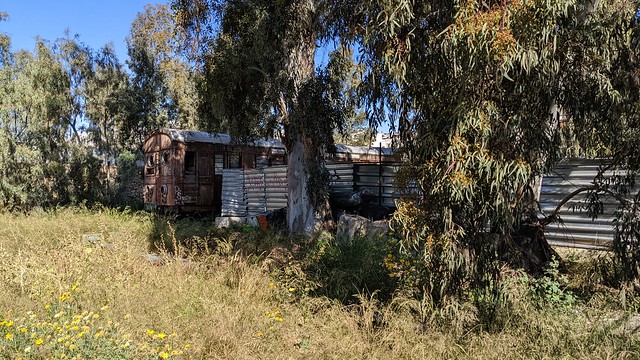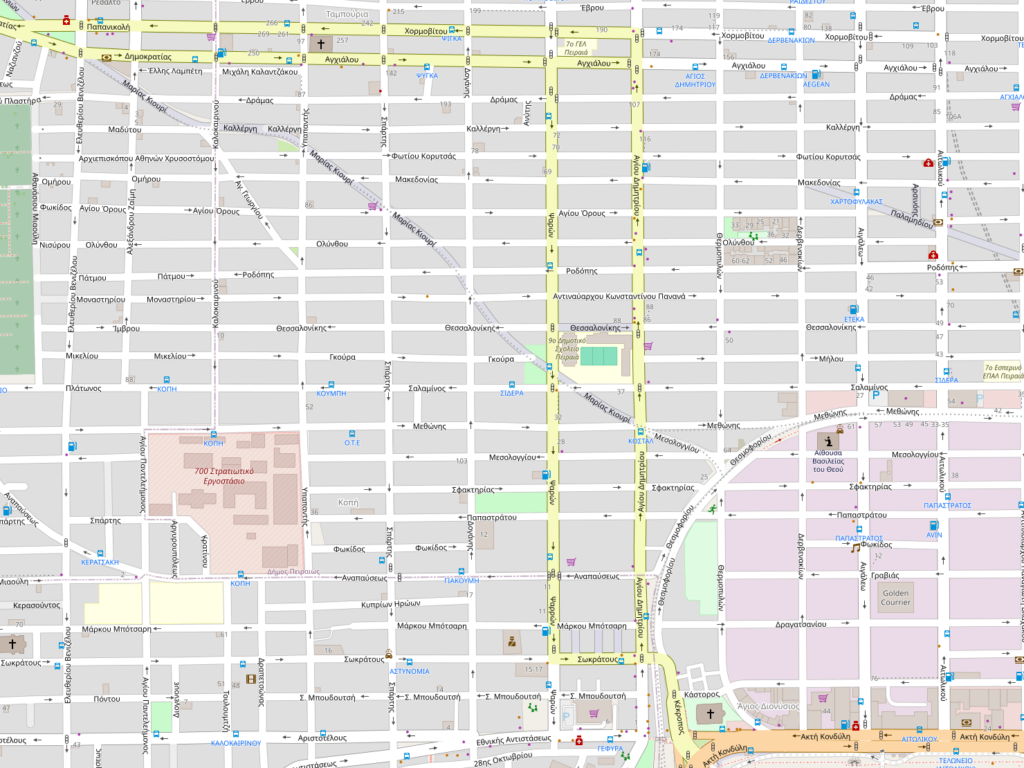The abandoned railways of Piraeus
Last year I went travelling to several places on the other side of the world. One of these was spending a couple of weeks exploring Greece.
The entire country is a treasure trove on almost every conceivable topic and I’ll be doing a series of posts to share the things I found and experienced along the way.
But in this post I’m going to focus on one of many side trips that I made while staying in Athens – seeking some of the many abandoned railways through the city’s ancient port of Piraeus (Πειραιάς).
Why Piraeus?
This place has been inhabited for thousands of years. Its strategic location and excellent natural harbours made it a very important site ever since.
One of its most famous periods was during the Classical Greece period and its strong relationship with Athens during the peak of its influence and power. The Athenian Navy was one of the city-state’s most important assets and its spiritual and operational home was here in Piraeus.
The ‘Long Walls‘ were built under the oligarchs Pericles and Cimon to protect the route from Athens to its port from attack. Unfortunately due to a series of unfortunate events, including a plague and several battles, Piraeus fell from grace and didn’t recover for thousands of years.

To cut a long story short, one of the first railways in Greece was built in 1869 between Athens and Piraeus. Like many other countries at the time, this was a period of rapid railway expansion that continued well into the 20th century. In the case of Greece, it was also an important part of building a nation after the War of Independence. Given Piraeus’ status as an increasingly important maritime and industrial centre, much of the national reconstruction effort went towards this area.
The result was a large number of railways and other infrastructure built right across the city. The steep mountains to the north also restricted where these could be built, resulting in some meandering routes.
Then like many other countries, these industrial railways gradually fell into disuse as trucks and road transport were prioritised and replaced rail traffic. While there is still a fair bit of goods traffic carried on rails in Greece it’s a far cry from its heyday.
So this background leads us to why I decided to take a walk around Piraeus to see how many of these abandoned railways I could find and what is left of them today.
The first Piraeus railway station
I caught the Athens Metro Line 1 to the 1869 Piraeus Station building – which today serves the Athens Metro. It’s a beautiful building that was extensively renovated in the 1920s which clearly shows.
It also houses the Electric Railways Museum which was very interesting but unfortunately does not permit photography as it is a private collection.

Although it is a very pretty building this was not my intended destination in this first part.
I headed due east towards the other side of the huge ferry terminal that greets you as soon as you exit the station. On the other side of the harbour is the ‘other’ Piraeus Railway Station, built in 1904. Although it did carry regional passenger traffic to destinations outside and on the periphery of metropolitan Athens, its main benefit was direct access through a series of yards, sidings and branch lines to port facilities and factories.
It closed in 2004 and was meant to be renovated but instead closed permanently after the Olympic Games. It has set derelict ever since despite promises to repurpose it for different uses.

The old station sign and even a reasonably new OSE logo are still on the front.
Nearby there is a small footbridge just north of the station that gives you a great view of the station platforms, yards and the incredible single track that leads here.
This track is an amazing and picturesque piece of infrastructure that was carefully built in a very narrow corridor in between the densely-packed residential and commercial buildings of the port.

There are some abandoned wagons and passenger carriages left in the sidings that you can just see peering through the fence.

The Piraeus-Perama light railway
A little further north along this cute single track, which we will return to later, is the abandoned tracks of the Piraeus-Perama light railway (Τραμ Περάματος).
One thing in Greece is that unlike Australia, a lot of abandoned railway infrastructure is left behind. With some exceptions, the almost complete eradication of any trace of a railway does not appear to happen here nearly as much. Which I think is wonderful for exploration like this!
This light railway operated from 1936 to 1977 and provided an urban railway transport link between the centre of Piraeus and the naval base in the western centre of Perama.
If you are coming from the present-day Line 1 station, the first signs of this railway are on Thermopylon Street (Θερμοπυλών) which curves in a way that is very different to the surrounding grid network.

This continues along Maria Kiouri (Μαρίας Κιουρί) which is a nice pedestrian street created many years after the railway closed. While there are some sections where residents have parked their cars it is mostly car-free the entire way.
It functions as a linear park with some playgrounds, trees and benches along the way, together with some shops and cafes. I was there on Orthodox Easter Sunday which made it a little quieter than usual as most things were closed.

The tracks have been left embedded in the road surface at most of the former level crossings and even some of the old station sites. These are easily visible if you keep an eye out.


I didn’t walk all the way along the line but this appears to continue all the way to Perama. Apparently there is an abandoned light rail vehicle at the terminus as well.
The old railway to Athens
Doubling back along Maria Kiouri I came across what would be a rare sight on Australian railways. Here the Perama light railway crosses the old single track line leading north-east towards Athens at an almost right angle.

This connection has been disused since the original Piraeus Station closed back in 2004 but incredibly almost all of the infrastructure is still here; everything from telephones and tracks to level crossing bells and signs.
You can walk along the tracks themselves or the narrow streets that run alongside them and explore all of these remnants at will.


Some particularly interesting spots for me were where trolleybus lines crossed the railway. There was netting around the wires here – I’m unsure why but I assume it had something to do with protecting them from any errant protrusions on top of goods trains.

Further towards Athens were more abandoned railway buildings as part of the former yards and level crossings. The tracks here are almost all gone but you can still pretty clearly see where they used to run.

There is also the former depot here that is now used as the new Railway Museum of Athens. Unfortunately it was closed when I walked by but you can see the sidings that lead inside.

There is heaps more to explore but I decided to stop here and call it a day.
One small sidenote – if you are following this walk you must visit the level crossing on the Υμηττού road near the Museum. Like a surprising number of level crossings on active railways in Greece and even Athens, this is manually operated by hand.

The way this works is that a railways worker sits in the booth and gets instructed when to raise and lower the boom gates which they do by rotating a wheel that does so. I even saw some later in the trip that had no boom gates and just a worker standing on the road holding a red flag – pretty incredible given the comparatively intense safety measures put in place in Australia.
Know before you go
If you are planning to do this walk allow about two hours or so to do it properly. There is a lot to see along the way so make sure you do it justice.
Be aware that there are some abandoned buildings near the port in particular where some squatters live and in general feels a bit sketchy. They will generally leave you alone if you do the same but it’s probably not the best idea to hang around there for too long.
If you have the time it is probably worth the trip out to Perama. There are trolleybus and bus routes that service the area.
All of the photos above are geotagged if you click through to the Flickr pages.

1 Comment
Join the discussion and tell us your opinion.
Sounds Great Phil. Being half-Greek (Grandmother from Rhodes, Grandfather from Kastellorizo), I am reading with interest!